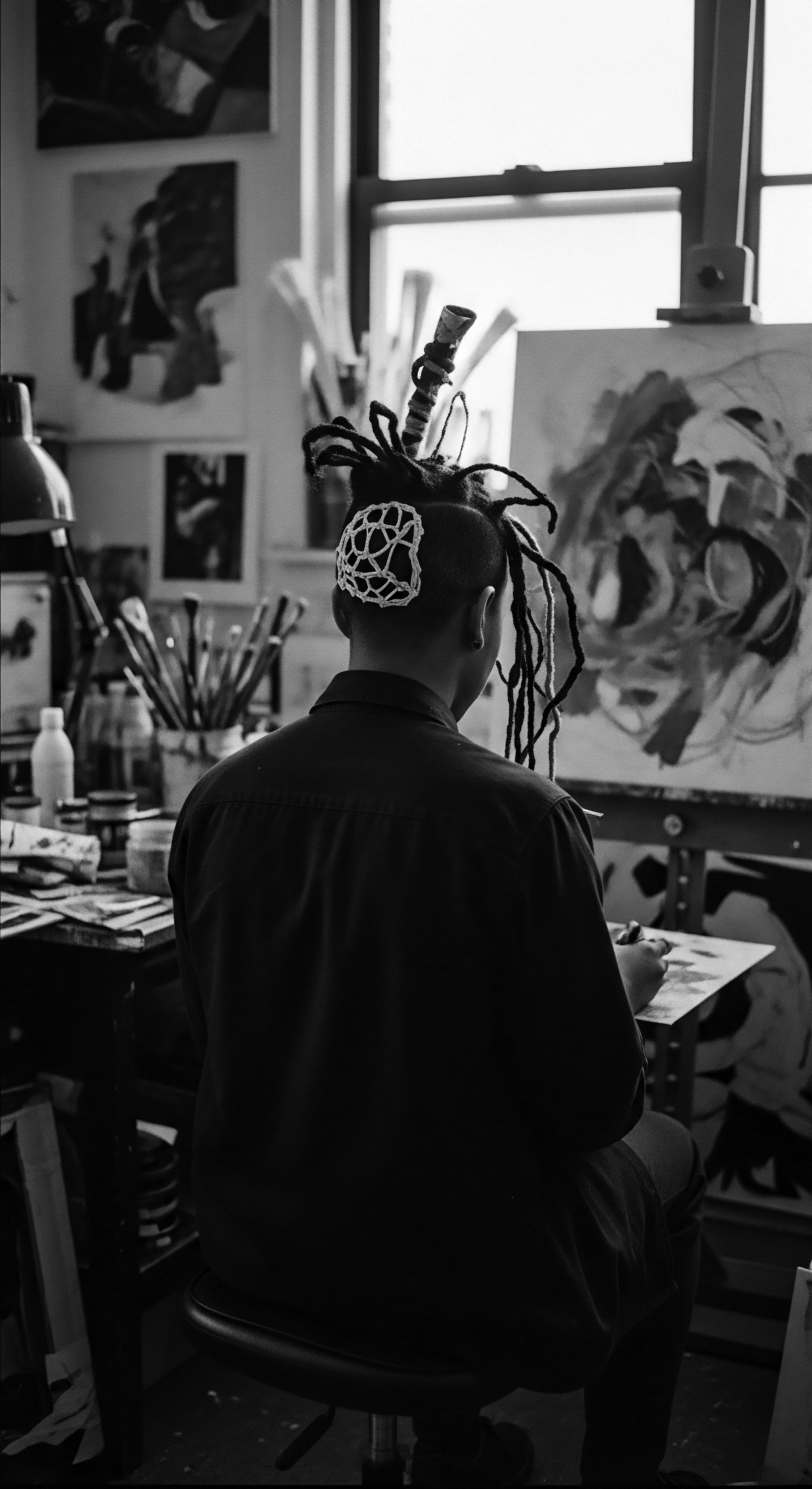
Fundamentals
Within the profound tapestry of Roothea’s ‘living library,’ the concept of Epigenetic Scars emerges as a compelling lens through which we may understand the inherited narratives etched onto our very strands. This term, at its most fundamental, speaks to the biological memory carried within our cells, passed from one generation to the next, without altering the underlying genetic code. Imagine our DNA as a vast, ancient scroll, containing the blueprint of who we are. Epigenetics concerns the annotations, highlights, and whispered instructions added to that scroll, dictating which parts are read and how loudly, influencing the expression of our inherited traits.
These modifications are not permanent changes to the letters of our genetic story, but rather adjustments to the way that story is told and interpreted across lifetimes. They represent a subtle, yet powerful, layer of inheritance.
When we speak of “scars” in this context, we are not referring to physical wounds on the hair itself, but rather to the enduring imprints of environmental and lived experiences that register at a cellular level. These imprints can influence how our hair grows, its texture, its resilience, and even its response to care. Consider the ancestral experiences of textured hair communities, particularly those of Black and mixed-race individuals. Generations faced displacement, forced labor, nutritional deprivation, and the profound psychological stress of systemic oppression.
These historical realities were not merely events of the past; they became woven into the biological fabric of descendants. For instance, chronic stress, a persistent companion for many within the African diaspora, has been shown to trigger epigenetic modifications that impact hair follicle cycling and may contribute to hair loss. This suggests that the trials endured by our foremothers and forefathers could have left biological echoes, subtle directives influencing the very nature of our hair today.
Epigenetic Scars represent the biological memory of lived experiences, subtly influencing how our hair’s inherited blueprint is expressed across generations.
Understanding this foundational meaning allows us to view hair not merely as an aesthetic feature, but as a living archive, holding whispers of journeys spanning continents and centuries. The texture, the curl, the strength, the challenges—each may carry a lineage of adaptation and survival. Traditional hair care practices, passed down through families, often contained intuitive wisdom for mitigating these subtle biological imprints, even if the underlying science was then unknown.
These practices, such as deep oiling, protective styling, and communal grooming rituals, served as acts of resilience and care, perhaps unconsciously working to soothe the cellular memory of past adversities and promote robust hair health. They were, in essence, early forms of epigenetic support, fostering an environment where hair could thrive despite the historical weight it carried.

Intermediate
Building upon the fundamental understanding of Epigenetic Scars, we may now explore the deeper mechanisms through which these ancestral imprints manifest within the very biology of textured hair. The subtle alterations to gene expression, which do not change the underlying DNA sequence, are primarily mediated through processes such as DNA Methylation, Histone Modification, and the influence of Non-Coding RNAs. DNA methylation involves the addition of chemical tags, called methyl groups, to specific regions of our DNA. These tags can act like dimmer switches, turning genes “off” or “on,” influencing their activity levels.
Histone modifications, alternatively, involve changes to the proteins around which DNA is wrapped, altering how tightly the DNA is packaged and thus its accessibility for gene expression. Non-coding RNAs also play a part, regulating gene activity without themselves coding for proteins. These molecular dance partners choreograph the expression of genes responsible for hair follicle development, growth cycles, and the unique characteristics of textured hair.
Consider the historical trajectory of Black and mixed-race hair experiences, where chronic exposure to systemic stressors has been a pervasive reality. The stress of discrimination, the demands of forced assimilation into Eurocentric beauty standards, and the nutritional shifts imposed by displacement have all left their mark. Chronic stress, a consistent companion for many within the African diaspora, has been linked to epigenetic modifications that impact hair follicle cycling, potentially leading to hair loss or changes in growth patterns. These environmental pressures, experienced across generations, can lead to the biological embedding of social experiences, where societal inequities translate into physiological alterations.
The concept of Intergenerational Trauma provides a powerful framework for comprehending how these Epigenetic Scars persist. Research suggests that traumatic experiences endured by parents or even ancestors can lead to epigenetic changes that are then passed down to subsequent generations, influencing their stress reactivity, biochemistry, and behavior. This means that the profound suffering and resilience of our forebears, for example, during periods of enslavement or intense racial discrimination, could be reflected in the biological predispositions of hair today. This is not to say that hair is inherently “damaged,” but rather that it carries a legacy of adaptation to challenging environments.
Epigenetic Scars manifest through DNA methylation and histone modifications, biological echoes of intergenerational stressors like discrimination and nutritional shifts, influencing hair’s inherent characteristics.
The impact of these Epigenetic Scars on textured hair can be seen in various ways. For instance, the very structure of Afro-textured hair, with its elliptical cross-section and high curvature, makes it more susceptible to mechanical stress and breakage. While this is a genetic predisposition, the historical context of hair care practices, often involving harsh chemical straighteners or tension-inducing styles driven by societal pressures, could have exacerbated these vulnerabilities over generations, leading to increased instances of conditions like traction alopecia.
The continuous pressure to conform to beauty ideals that devalued natural textures may have contributed to a cycle of hair manipulation that inadvertently deepened these epigenetic imprints. Recognizing this connection allows us to approach hair care not as a superficial act, but as a practice of healing and reclamation, acknowledging the wisdom of ancestral practices that sought to preserve and honor the hair’s natural integrity.

Academic
The academic delineation of Epigenetic Scars within the context of textured hair heritage represents a convergence of molecular biology, social epidemiology, and the anthropology of human experience. This term denotes the discernible, often heritable, alterations in gene expression patterns—without modifications to the underlying DNA sequence—that arise as a biological embedding of cumulative environmental stressors, particularly those linked to systemic adversity and intergenerational trauma within historically marginalized communities. The significance of this concept lies in its capacity to provide a mechanistic explanation for how societal conditions, lived experiences, and ancestral legacies translate into observable phenotypic variations, including those related to hair morphology, growth dynamics, and resilience. This explication moves beyond a simplistic genetic determinism, positing that while an individual’s genome provides the foundational blueprint, their epigenome acts as a dynamic interface, registering the historical and ongoing dialogue between genetic predispositions and environmental exposures.
Central to the manifestation of Epigenetic Scars are intricate molecular mechanisms. DNA Methylation, the addition of a methyl group to cytosine bases, often within CpG islands, can effectively silence gene transcription or alter gene activity, acting as a profound regulatory switch. Concurrently, Histone Modifications, such as acetylation, methylation, or phosphorylation of histone proteins, remodel chromatin structure, thereby modulating the accessibility of DNA to transcriptional machinery. These epigenetic marks are not static; they possess a degree of plasticity, capable of being influenced by diet, stress, toxicant exposure, and even social interactions across the lifespan.
Crucially, research indicates that certain epigenetic modifications can be transmitted across generations, a phenomenon termed Transgenerational Epigenetic Inheritance. This biological legacy implies that the chronic stressors endured by one generation can influence the health and physiological responses of subsequent generations, even in the absence of direct exposure to the initial stressor.

The Biological Embedding of Historical Adversity in Textured Hair
The academic discourse on Epigenetic Scars gains particular salience when examining the enduring impact of historical trauma on textured hair communities. The systematic oppression, forced displacement, and racial discrimination experienced by individuals of African descent, for instance, represent profound and chronic environmental stressors. These stressors induce a sustained activation of the hypothalamic-pituitary-adrenal (HPA) axis, leading to elevated levels of stress hormones like cortisol.
Chronic cortisol exposure has been linked to detrimental effects on hair follicle cycling, potentially pushing follicles prematurely into the resting (telogen) phase and contributing to hair shedding or thinning. Furthermore, systemic racism and the pressure to conform to Eurocentric beauty standards have historically compelled Black women to utilize harsh chemical straighteners or tension-inducing hairstyles, practices that themselves can cause hair damage and hair loss conditions such as traction alopecia.
A compelling area of inquiry involves the biological embedding of these social experiences. For example, studies suggest that chronic stress and nutritional deficiencies experienced by Black Americans during slavery have led to epigenetic changes that contribute to poorer physical and mental health outcomes in descendants. This means that the physiological responses to historical conditions of scarcity and extreme duress may have left epigenetic imprints that affect metabolic processes, inflammatory responses, and stress reactivity in ways that could indirectly influence hair health and appearance. While direct epigenetic links to hair texture changes due to historical trauma are still being fully elucidated, the connections between stress, inflammation, and hair follicle health are well-established.
Epigenetic Scars denote heritable alterations in gene expression, influenced by cumulative environmental stressors and intergenerational trauma, providing a biological mechanism for how societal conditions impact hair morphology and resilience.
One specific incidence that powerfully illuminates the connection between Epigenetic Scars and textured hair heritage lies in the persistent prevalence of stress-related hair conditions within Black communities. While individual stress is a factor, the concept of Racial Battle Fatigue, a term describing the cumulative physiological and psychological burden of dealing with racism, offers a compelling framework. This chronic, low-grade stress can lead to sustained physiological dysregulation. For instance, research indicates that chronic stress, a frequent experience for racial minorities, can lead to altered methylation profiles in stress-related genes like CRF and SLC6A4.
These changes are not merely individual responses; they represent the biological cost of systemic oppression. When considering hair, this sustained stress response, modulated epigenetically, can contribute to conditions like Telogen Effluvium, where hair follicles prematurely enter a resting phase, leading to excessive shedding. Moreover, the historical denigration of natural Black hair and the societal pressure to straighten it, a form of internalized racism, added another layer of stress. A 2023 survey revealed that 61% of Black respondents used chemical straighteners because they “felt more beautiful with straight hair,” despite these products containing harmful chemicals linked to health risks. This historical and ongoing psychological stress, compounded by chemical exposures, presents a complex interplay where societal pressures contribute to biological alterations that may be passed down or exacerbated across generations, manifesting as hair health challenges.
The academic meaning of Epigenetic Scars therefore extends beyond a mere biological phenomenon; it encompasses a profound sociocultural and historical dimension. It compels researchers to consider the deeply embedded legacy of social injustice within the very biology of marginalized populations. This perspective demands a re-evaluation of health disparities, moving beyond individual blame to acknowledge the systemic and intergenerational factors that shape biological outcomes. Future research endeavors must continue to disentangle the specific epigenetic pathways through which social determinants of health influence hair biology, potentially identifying targets for interventions that are not only scientifically sound but also culturally resonant and historically informed.
To further contextualize this understanding, we may consider how historical practices, often dismissed as anecdotal, find resonance within modern epigenetic insights. The traditional wisdom of various African and Indigenous communities often centered on holistic well-being, recognizing the interconnectedness of mind, body, and spirit, with hair frequently serving as a spiritual conduit.
| Traditional Practice/Ingredient Oiling Scalp and Hair with Natural Butters/Oils (e.g. Shea Butter, Chebe Powder mixtures) |
| Cultural Context West African traditions, often for length retention and moisture. Basara women of Chad use Chebe for hair maintenance. |
| Potential Epigenetic/Biological Link Provides emollients and antioxidants, potentially protecting hair follicles from environmental damage and oxidative stress that can induce epigenetic changes. |
| Traditional Practice/Ingredient Protective Styling (Braids, Twists, Locs) |
| Cultural Context Ancient African societies used hairstyles to convey status, identity, and for practical hair management. |
| Potential Epigenetic/Biological Link Reduces daily manipulation and breakage, minimizing physical stress on hair follicles. This can indirectly reduce inflammatory responses that may have epigenetic consequences. |
| Traditional Practice/Ingredient Herbal Rinses and Washes (e.g. Rosemary, Fenugreek) |
| Cultural Context Ethnobotanical practices across Africa and diaspora for cleansing, stimulating growth, and scalp health. |
| Potential Epigenetic/Biological Link Contains bioactive compounds that may possess anti-inflammatory or antioxidant properties, supporting a healthy scalp microenvironment and potentially influencing gene expression related to hair growth and health. |
| Traditional Practice/Ingredient Communal Hair Grooming Rituals |
| Cultural Context Deeply rooted in African and Indigenous cultures, fostering connection, knowledge transfer, and emotional support. |
| Potential Epigenetic/Biological Link Reduces psychosocial stress through social bonding and communal care. Chronic stress is a known inducer of adverse epigenetic modifications affecting hair. |
| Traditional Practice/Ingredient These ancestral practices, often rooted in deep cultural wisdom, offer insights into how environmental factors and holistic care may have historically influenced hair health, resonating with contemporary epigenetic understanding. |

Interconnected Incidences ❉ The Socio-Epigenetic Landscape of Hair
The concept of Epigenetic Scars also compels us to examine the intricate interconnections between social determinants of health and hair biology. The field of social epigenetics explicitly investigates how adverse social environments, including experiences of racism and discrimination, are associated with alterations in the epigenome. These alterations can contribute to health disparities observed across racialized groups. The persistent denigration of natural Black hair, for instance, and the societal pressure to conform to Eurocentric beauty standards, have created a unique form of chronic stress for Black women.
This stress is not merely psychological; it has tangible biological consequences. When individuals are subjected to continuous microaggressions or systemic barriers related to their appearance, the body’s stress response system remains activated. This prolonged activation can lead to epigenetic changes in genes associated with stress response and inflammation, potentially impacting hair follicle health and contributing to conditions like alopecia.
Furthermore, the historical legacy of nutritional deficiencies, particularly during periods of enslavement and subsequent economic disenfranchisement, presents another layer of epigenetic influence. While modern diets may be more varied, the historical deprivation of essential nutrients could have induced epigenetic modifications that impact nutrient absorption or metabolic pathways relevant to hair health across generations. This historical dietary landscape, combined with the stress of survival, could have predisposed textured hair to certain vulnerabilities, making it more susceptible to breakage or slower growth in subsequent generations.
The academic understanding of Epigenetic Scars thus encourages a holistic and historically informed approach to hair science, recognizing that the health and appearance of textured hair are not solely a matter of individual genetics or current care practices, but are deeply intertwined with ancestral experiences and ongoing societal conditions. This perspective opens pathways for interventions that address not only the immediate biological manifestations but also the deeper, inherited socio-epigenetic landscape.

Reflection on the Heritage of Epigenetic Scars
The journey through the intricate concept of Epigenetic Scars within Roothea’s ‘living library’ is more than an academic exercise; it is a profound meditation on the enduring spirit of textured hair and its ancestral lineage. Our exploration reveals that hair, in its myriad forms, carries not only the visible markers of our genetic inheritance but also the silent, cellular echoes of collective human experiences. It speaks of survival, of adaptation, and of the unyielding spirit of those who came before us. This understanding transforms our perception of hair from a mere adornment to a sacred artifact, a living testament to journeys through time and trials.
The ‘Soul of a Strand’ ethos reminds us that every coil, every wave, every tightly bound curl holds a story, a memory, a biological whisper from generations past. It is a recognition that the strength and challenges observed in textured hair today are not isolated phenomena, but rather expressions of a deep historical dialogue between human biology and the social environment. To comprehend Epigenetic Scars is to honor the resilience of our ancestors, to acknowledge the weight of their experiences, and to appreciate the profound ways in which their lives continue to resonate within our own. This knowledge becomes a compass, guiding us toward care practices that are not just scientifically informed, but also culturally resonant, imbued with the wisdom of tradition.
Understanding Epigenetic Scars deepens our reverence for textured hair, recognizing it as a living archive of ancestral resilience and a guide for holistic care.
In this ‘living library,’ we do not seek to pathologize the past, but rather to illuminate its lingering presence, transforming perceived vulnerabilities into points of connection and understanding. The Epigenetic Scars, then, are not blemishes, but rather indelible marks of an enduring heritage, prompting us to approach textured hair with a reverence that transcends fleeting trends. It calls upon us to listen to the whispers of our strands, to learn from the tender threads of ancestral care, and to move forward with a profound sense of purpose, shaping a future where every helix is unbound, celebrated, and nourished with wisdom from the source.

References
- Byrd, A. D. & Tharps, L. I. (2001). Hair story ❉ Untangling the roots of Black hair in America. St. Martin’s Press.
- Carey, N. (2012). The epigenetics revolution ❉ How modern biology is rewriting our understanding of genetics, disease, and inheritance. Columbia University Press.
- Francis, R. C. (2011). Epigenetics ❉ How environment shapes our genes. W. W. Norton & Company.
- Jacobs-Huey, L. (2006). From the kitchen to the salon ❉ Language and cultural co-construction in the African American beauty shop. Oxford University Press.
- Patton, M. F. (2006). Hair story ❉ The art of African-American hair styling. Simon & Schuster.
- Post, R. M. (2021). The epigenetic connection to black disparity. Journal of Clinical Psychiatry, 82(3), 21com13858.
- Roberts, D. (2011). Fatal invention ❉ How science, politics, and big business re-create race in the twenty-first century. The New Press.
- Skinner, M. K. (2014). Environmental epigenetic transgenerational inheritance. F1000Prime Reports, 6.
- Ward, J. S. (2021). The legacy of trauma ❉ African American intergenerational trauma and healing. University of San Francisco.
- Weaver, I. C. G. Champagne, F. A. Brown, S. E. Dymov, S. & Meaney, M. J. (2005). Reversal of maternal programming of stress responses in adult offspring through cross fostering. Nature Neuroscience, 8(3), 346-352.
